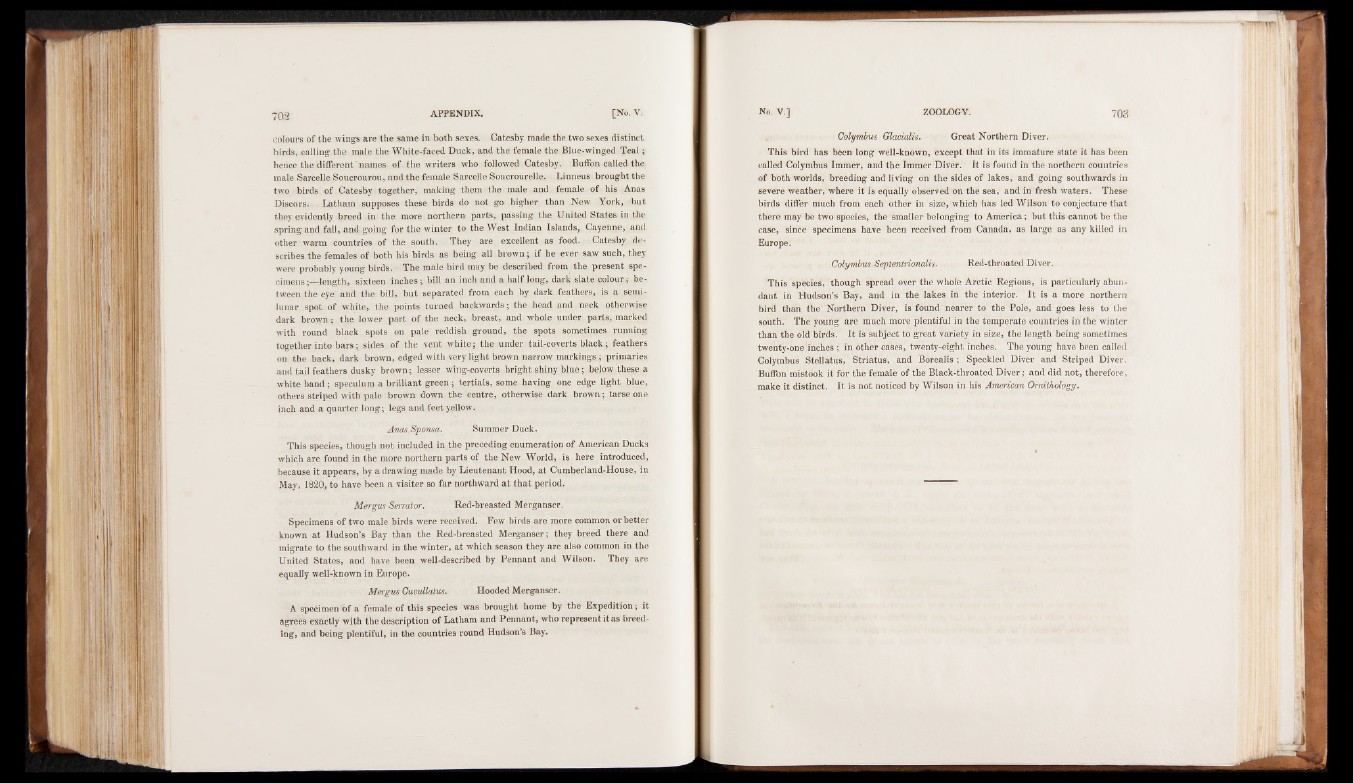
colours of the wings are the same in both sexes. Catesby made the two sexes distinct
birds, calling the male the White-faced Duck, and the female the Blue-winged Teal;
hence the different names of the writers who followed Catesby. Buffon called the
male Sarcelle Soucrourou, and the female Sarcelle Soucrourelle. Linneus brought the
two birds of Catesby together, making them the male and female of his Anas
Discors. Latham supposes these birds do not go higher than New York, but
they evidently breed in the more northern parts, passing the United States in the
spring and fall, and going for the winter to the West Indian Islands, Cayenne, and
other warm countries of the south. They are excellent as food. Catesby describes
the females of both his birds as being all brown; if he ever saw such, they
were probably young birds. The male bird may be described from the present specimens
;__length, sixteen inches; bill an inch and a half long, dark slate colour; between
the eye and the bill, but separated from each by dark feathers, is a semilunar
spot of white, the points turned backwards; the head and neck otherwise
dark brown ; the lower part of the neck, breast, and whole under parts, marked
with round black spots on pale reddish ground, the spots sometimes running
together into bars; sides of the vent white; the under tail-coverts black; feathers
on the back, dark brown, edged with very light brown narrow markings; primaries
and tail feathers dusky brown; lesser wing-coverts bright shiny blue; below these a
white band ; speculum a brilliant green ; tertials, some having one edge light blue,
others striped with pale brown down the centre, otherwise dark brown; tarse one
inch and a quarter long; legs and feet yellow.
Anas.Sponsa. . Summer Duck.
This species, though not included in the preceding enumeration of American Ducks
which are found in the more northern parts of the New World, is here introduced,
because it appears, by a drawing made by Lieutenant Hood, at Cumberland-House, in
May, 1820, to have been a visiter so far northward at that period.
Mergzis Senator. Red-breasted Merganser.
Specimens of two male birds were received. Few birds are more common or better
known at Hudson’s Bay than the Red-breasted Merganser; they breed there and
migrate to the southward in the winter, at which season they are also common in the
United States, and have been well-described by Pennant and Wilson. They are
equally well-known in Europe.
Mergzis Cucullatus. Hooded Merganser.
A specimenbf a female of this species was brought home by the Expedition; it
agrees exactly with the description of Latham and Pennant, who represent it as breeding,
and being plentiful, in the countries round Hudson’s Bay.
^ Colymbus Gladalis. Great Northern Diver.
This bird has been long well-known, except that in its immature state it has been
called Colymbus Immer, and the Immer Diver. It is found in the northern countries
of both worlds, breeding and living on the sides of lakes, and going southwards in
severe weather, where it is equally observed on the sea, and in fresh waters. These
birds differ much from each other in size, which has led Wilson to conjecture that
there may be two species, the smaller belonging to America; but this cannot be the
case, since specimens have been received from Canada, as large as any killed in
Europe.
Colymbus Septentrionalis. Red-throated Diver.
This species, though spread over the whole Arctic Regions, is particularly abundant
in Hudson’s Bay, and in the lakes in the interior. It is a more northern
bird than the Northern Diver, is found nearer to the Pole, and goes less to the
south. The young are much more plentiful in the temperate countries in the winter
than the old birds. It is subject to great variety in size, the length being sometimes
twenty-one inches ; in other cases, twenty-eight inches. The young have been called
Colymbus Stellatus, Striatus, and Borealis; Speckled Diver and Striped Diver.
Buffon mistook it for the female of the Black-throated Diver; and did not, therefore,
make it distinct. It is not noticed by Wilson in his American Ornithology.